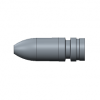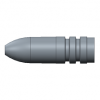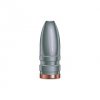Dimner
Named Man
In the "Elvis 61 grain" Ian mentioned something that caught my eye:
Caught my eye for two reasons:
1) I'm that guy when doing conventional lubed bullets goes 2-3 thous over groove diameter. It's always worked great for me in 30 cals, therefore that has translated to how I have been approaching my PC bullets for my 223 wylde AR15. Doh!
2) I have been struggling with accuracy with my 223 wylde ar15 load. Chasing variables in the most pathetic, non-scientific manner. So I am trying to get back to basics. Seeing Ian's quote leads me to believe that I am far over the size I should be.
So with that little confession... I get the feeling that there has been more discussion about powder coat bullets and their relationship with bore size or topics on how the PC behaves during it's initial obturation and then path down the barrel. Could someone point me to these threads? Before I make a post about all my attempts and struggles, I would like to read more about PC and how it interacts with the bore. Basically, I have been (wrongly) treating PC as a direct substitute for conventional lube. I need to fill that knowledge gap. How does PC behave from primer strike till exit from the barrel?
(emphasis is mine)Stubborn, plastic bore fouling at high velocity and accuracy problems at low velocity together with bore leading are the usual complaints with slicks but it doesn't always happen. I personally think that keeping coated monoliths closer groove diameter than throat entrance diameter is a key point to managing lead and plastic bore fouling. Those who go about the coated cast bullet thing the same way they do conventional lubricated bullets by making them 2, 3, or even 4 thousandths larger than groove diameter nay not have very good results, especially with slicks.
Caught my eye for two reasons:
1) I'm that guy when doing conventional lubed bullets goes 2-3 thous over groove diameter. It's always worked great for me in 30 cals, therefore that has translated to how I have been approaching my PC bullets for my 223 wylde AR15. Doh!
2) I have been struggling with accuracy with my 223 wylde ar15 load. Chasing variables in the most pathetic, non-scientific manner. So I am trying to get back to basics. Seeing Ian's quote leads me to believe that I am far over the size I should be.
So with that little confession... I get the feeling that there has been more discussion about powder coat bullets and their relationship with bore size or topics on how the PC behaves during it's initial obturation and then path down the barrel. Could someone point me to these threads? Before I make a post about all my attempts and struggles, I would like to read more about PC and how it interacts with the bore. Basically, I have been (wrongly) treating PC as a direct substitute for conventional lube. I need to fill that knowledge gap. How does PC behave from primer strike till exit from the barrel?






